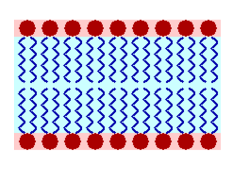Material with Potential for Purification and Drug Delivery
Published on by Water Network Research, Official research team of The Water Network in Academic
Scientists have created a new material that performs like a cell membrane found in nature. Such a material has long been sought for applications as varied as water purification and drug delivery.
Referred to as a lipid-like peptoid (we'll unpack that in a second), the material can assemble itself into a sheet thinner, but more stable, than a soap bubble, the researchers report July 12 in Nature Communications . The assembled sheet can withstand being submerged in a variety of liquids and can even repair itself after damage.
 "Nature is very smart. Researchers are trying to make biomimetic membranes that are stable and have certain desired properties of cell membranes," said chemist Chun-Long Chen at the Department of Energy's Pacific Northwest National Laboratory. "We believe these materials have potential in water filters, sensors, drug delivery and especially fuel cells or other energy applications."
"Nature is very smart. Researchers are trying to make biomimetic membranes that are stable and have certain desired properties of cell membranes," said chemist Chun-Long Chen at the Department of Energy's Pacific Northwest National Laboratory. "We believe these materials have potential in water filters, sensors, drug delivery and especially fuel cells or other energy applications."
The amazing membrane
Cell membranes are amazing materials. Made from thin sheets of fatty molecules called lipids, they are at least ten times thinner than an iridescent soap bubble and yet allow cells to collectively form organisms as diverse at bacteria, trees and people.
Cell membranes are very selective about what they let pass through, using tiny embedded proteins as gatekeepers. Membranes repair dings to their structure automatically and change thickness to pass signals from the outside environment to the cell's interior, where most of the action is.
Scientists would like to take advantage of membrane properties such as gatekeeping to make filters or signaling to make sensors. A cell-membrane-like material would have advantages over other thin materials such as graphene. For example, mimicking a cell membrane's efficient gatekeeping could result in water purifying membranes that don't require a lot of pressure or energy to push the water through.
Synthetic molecules called peptoids have caught the interest of researchers because they are cheap, versatile and customizable. They are like natural proteins, including those that embed themselves in cell membranes, and can be designed to have very specific forms and functions. So Chen and colleagues decided to see if they could design peptoids to make them more lipid-like.
Designing membranes
Lipid molecules are long and mostly straight: They have a fatty end that prefers to hang out with other fats, and a water-like end that prefers the comfort of water. Because of this chemistry, lipid molecules arrange themselves with the fatty ends pointed toward each other, sandwiched between the water-loving ends pointed out. Scientists call this a lipid bilayer, essentially a sheet that envelops the contents of a cell. Proteins or carbohydrate molecules embed themselves in the membranous sheet.
Inspired by this, Chen and colleagues designed peptoids in which each base peptoid was a long molecule with one end water-loving and the other end fat-loving. They chose chemical features that they hoped would encourage the individual molecules to pack together. They examined the resulting structures using a variety of analysis methods, including some at the Advanced Light Source and the Molecular Foundry, two DOE Office of Science User Facilities at Lawrence Berkeley National Laboratory.
The team found that after putting the lipid-like peptoids into a liquid solution, the molecules spontaneously crystallized and formed what the scientists call nanomembranes -- straight-edged sheets as thin as cell membranes -- floating in the beaker. These nanomembranes maintained their structure in water or alcohol, at different temperatures, in solutions with high or low pH, or high concentrations of salts, a feat that few cell membranes could accomplish.
Read full article at: News Medical
Media
Taxonomy
- Technology
- Membranes
- Membrane Technology
- Materials